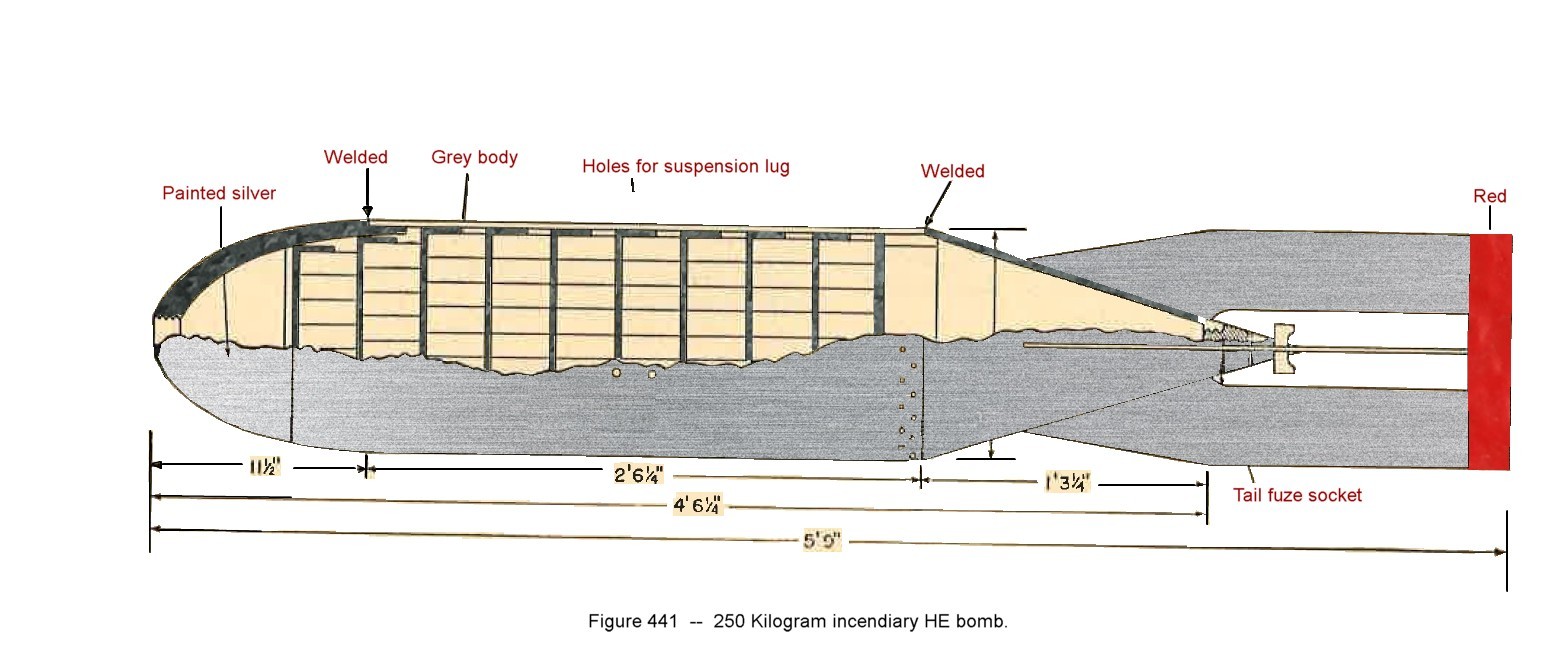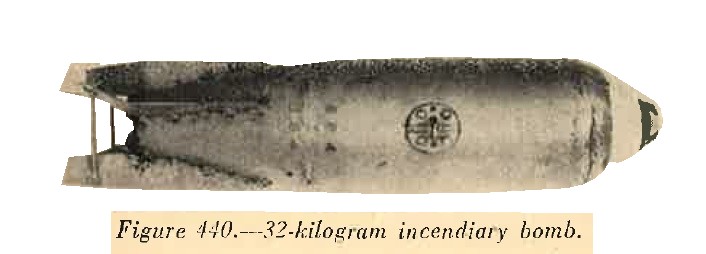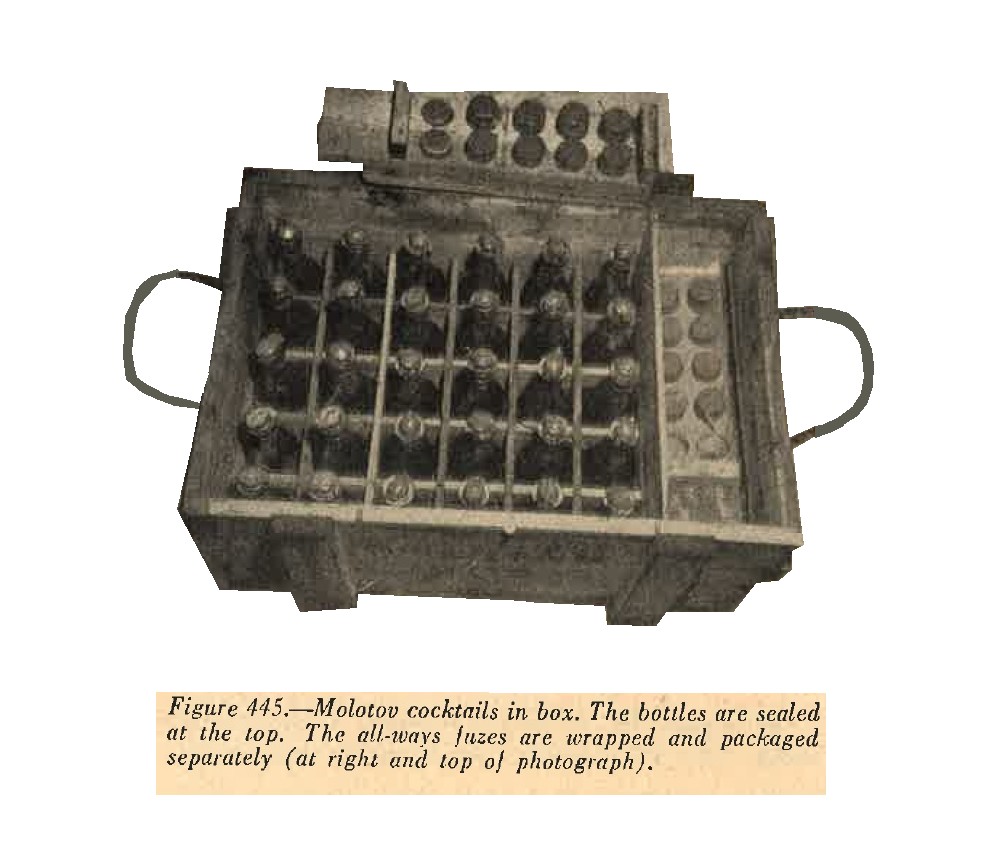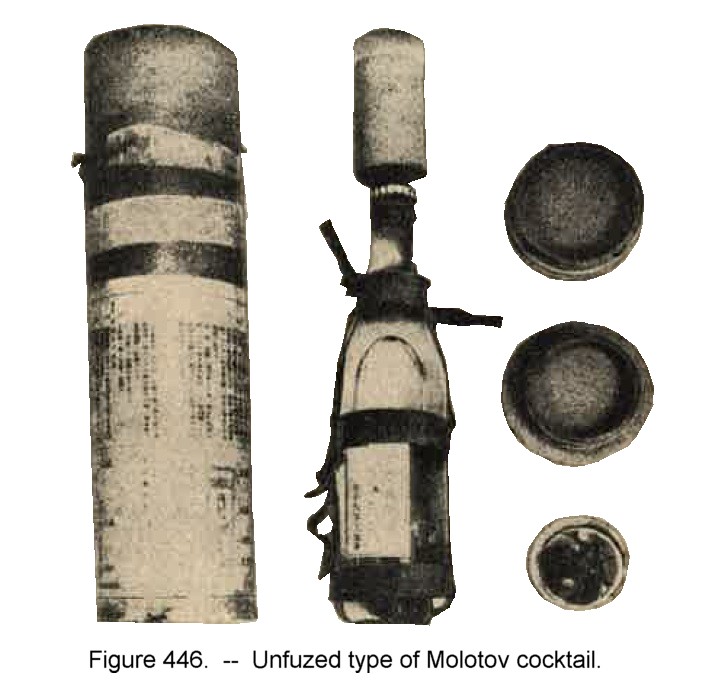| 1. |
Type 11 (1922) |
--------- |
70-mm snoke shell (mortar). |
| 2. |
Type 90 (1930) |
--------- |
75-mm smoke shell (artillery). |
| 3. |
Type 14 (1925) |
--------- |
105-mm smoke shell (artillery) |
| 4. |
Type 13 (1924) |
--------- |
150-mm smoke shell (artillery) |
The following shells are believed to be used primarily for their incendiary effect.
b. Type 90 (1930) 75-MM incendiary shell.
This shell has never been recovered (as of 1944), but iut is believed that it could be fired from any of the Japanese 75-mm
field guns, when fitted to the correct cartridge case. After a pre-set time, or on impact, the combination fuze fires an
expelling charge, the incendiary element being forced out through the base of the projectile.
| 1. |
Weight of projectile, fuzed |
--------- |
15.3 pounds. |
| 2. |
Weight of projectile, without fuze |
--------- |
13.5 pounds. |
| 3. |
Length of projectile, fuzed |
--------- |
12.1 inches. |
| 4. |
Length of projectile, without fuze |
--------- |
9.8 inches. |
| 5. |
Filling |
--------- |
1.2 pounds. |
| 6. |
Type of fuze |
--------- |
Type 5 (1916) modified combination (time and impact). |
| 7. |
Markings |
--------- |
Yellow body, with the Japanese Kana symbol (K) in contrasting color. |
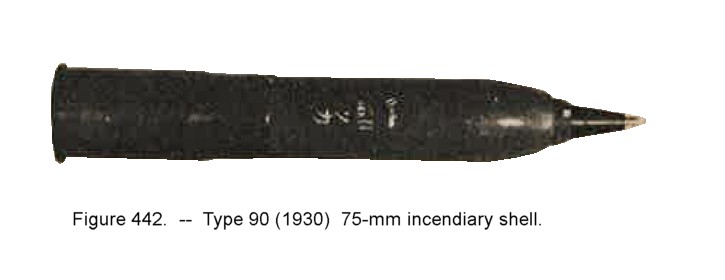
c. 75-mm incendiary shell.
The type number of this shell is not known (as of 1944), although specimens have been recovered. The forged steel body is of
conventional design and differs from the Type 90 (1930) incendiary in that it is fitted with an instantaneous nose fuze,
instead of a combination time and impact fuze. The incendiary filling consists of 96 rubber pellets immersed in a solution
of white phosphorus and carbon disulfide. It is believed that this projectile may be fired from any of the Japanese 75-mm
field guns when fitted to the corerct cartridge case.
Characteristics;
| 1. |
Weight, fuzed |
--------- |
11.8 pounds. |
| 2. |
Weight, without fuze |
--------- |
11.4 pounds. |
| 3. |
Length, fuzed |
--------- |
14.2 inches. |
| 4. |
Length, without fuze |
--------- |
11.9 inches. |
| 5. |
Nature of incendiary filling |
--------- |
Solution of 87.8 % white Phosphorus;
12.2 % carbon disulfide;
Containing rubber pellets.
|
| 6. |
Weight if incendiary filling |
--------- |
1.36 pounds. |
| 7. |
Type of fuze |
--------- |
Type 88 (1928) instantaneous. |
| 8. |
Markings |
--------- |
Blue-gray body;
Red band on fuze adapter;
Kana symbol in White;
|
d. 90-MM incendiary shell.
The dimensions and weight of this projectile are almost identical with those of the 90-mm Type 94 (1934) HE mortar shell. The
incendiary filling consists of a solution of white phosphorus and carbon disulfide containing 40 rubber pellets. This shell
may be fired from both the Type 94 (1934) and the Type 97 (1937) 90-mm mortars.
Characteristics;
| 1. |
Weight, fuzed |
--------- |
11.6 pounds. |
| 2. |
Length, fuzed |
--------- |
17.3 inches. |
| 3. |
Length, without fuze |
--------- |
15.9 inches. |
| 4. |
Diameter at bourrelet |
--------- |
3.53 inches. |
| 5. |
Number of fins |
--------- |
Six. |
| 6. |
Body material |
--------- |
Steel. |
| 7. |
Nature of chemical filling |
--------- |
White phosphorus and carbon disulfide, with 40 cylindrical rubber pellets. |
| 8. |
Weight of chemical filling |
--------- |
2.2 pounds. |
| 9. |
Type of fuze |
--------- |
Probably Type 93 (1933) instantaneous and short delay. |
| 10. |
Markings |
--------- |
Black body; red bank arond fuze adapter; blue band below red;
yellow band below bourrelet; white band above tail assembly.
|
e. Type 95 (1935) 105-mm incendiary shell.
No speciment of this shell has been recovered to date (1944). However, it is believed that it may be fired from all 105-mm guns
and howitzers when fitted with the suitable cartridge case.
Characteristics:
| 1. |
Weight, fuzed |
--------- |
35.2 pounds. |
| 2. |
Length, fuzed |
--------- |
14.8 inches. |
| 3. |
Nature of incendiary filling |
--------- |
Thermite. |
| 4. |
Weight of incendiary filling |
--------- |
11.8 pounds. |
| 5. |
Type of fuze |
--------- |
Type 5 (1916) modified combination (time and impact). |
13. WWII JAPANESE INCENDIARY GRENADES
a. General.
The following grenades are listed in this section for reference only as they are believed used primarily for their screening
rather than incendiary effect. Specifications will be found under "Smoke grenades", paragraph 15 of this section.
Type 11 (1922) 50-mm smoke grenade.
Rifle smoke grenade
The following grenades are considered to be used primarily as incendiaries.
b. Molotov cocktail (fuzed).
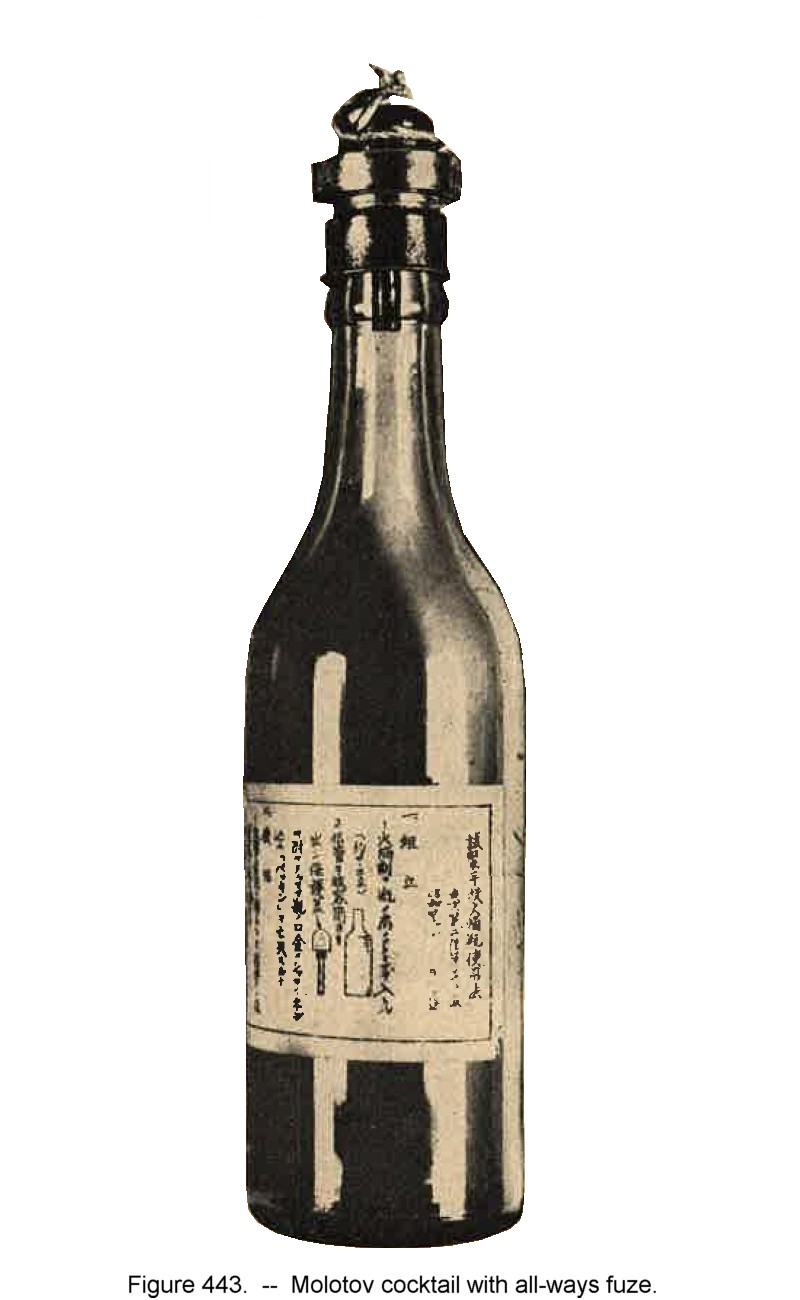 |
This consists of a standardize bottle filled with a mixture of oil and gasoline. The Fuze is an "all-ways" type that will function
when the grenade is thrown, no matter in what position the bottle lands, impact driving the firing pin down into the detonator
which ignites the contents of the bottle. The weight and capacity of the grenade will vary with the size of the bottle used.
|
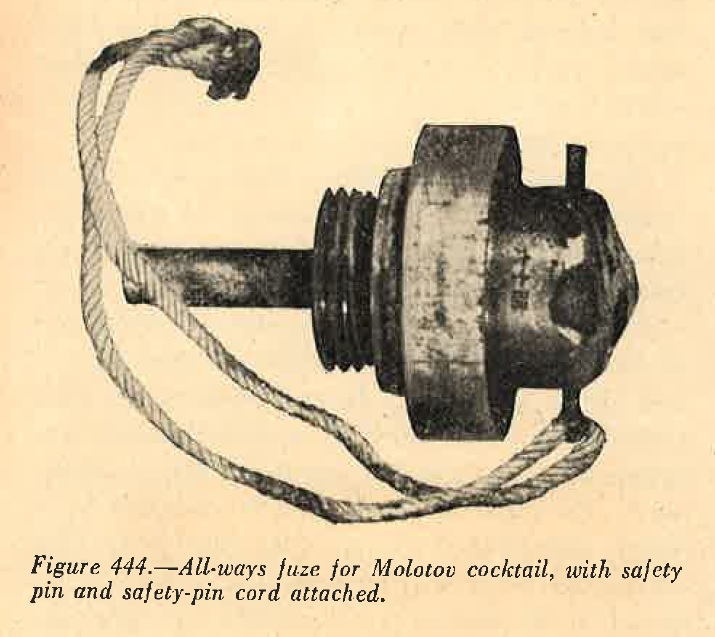 |
c. Molotov cocktail (unfuzed).
The weight and capacity of this grenade, like the fuzed Molotov cocktail, will depend upon the size of the bottle used. The
igniter consists of a circular glass dish, held against the bottom of the bottle by means of a cloth harness. The dish
contains a phosphorus compound, which ignites the contents of the bottle when the grenade is shattered on impact. It is
also reported that another version exists in which the phosphorus igniter is contained in a glass tube, housed inside the
bottle. A lead weight, attached to the igniter tube, ensures that it will fracture when the bottle is broken on impact.
d. Incendiary stick grenade.
This grenade consists of a cylindrical body to which a wooden handle is fitted. A standard Japanese hand-grenade fuze,
similar to that used with the Type 91 (1931) HE grenade, is screwed to the nose of the cylinder. The body of this
grenade is filled with rubber pellets impregnated with a solution of phosphorus and carbon disulfide. The pellets are
scattered by a central bursting charge. It is also possible that this grenade sometimes contains phosphorus only.
Characteristics:
| 1. |
Weight, fuzed |
--------- |
1.8 pounds * |
| 2. |
Length, fuzed |
--------- |
13.5 inches. |
| 3. |
Nature of incendiary filling |
--------- |
Solution of 68 percent white phosphorus and 32 percent carbon disulfide, containing 33 rubber pellets. |
| 4. |
Weight of incendiary filling |
--------- |
13.7 ounces. |
| 5. |
Type of fuze |
--------- |
Type 10 (1921) with 4 to 5 seconds delay. |
| 6. |
Markings |
--------- |
Gray body; Kana symbol (K) in white. |
* A recovered speciment (1944) weighed 1.6 pounds and contained 10.8 ounces of incendiary filling.
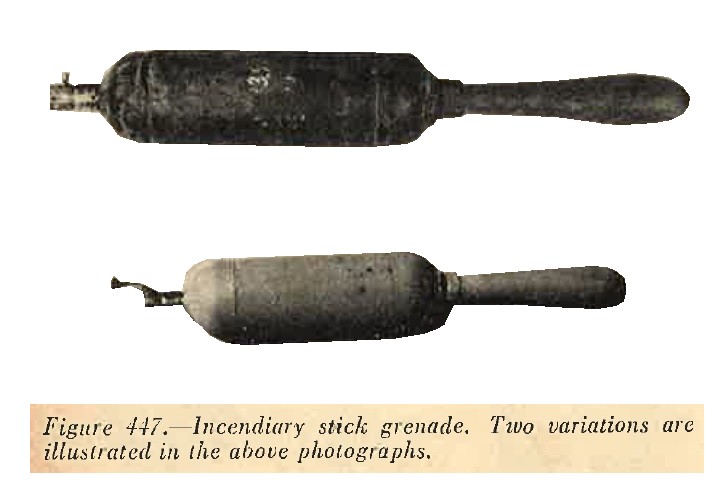
14. WWII JAPANESE ILLUMINATING SHELLS
a. Type 10 (1921) 50-mm signal flares.
(1) General.
These flares, which are produced in a variety of colors, are designed to be fired from the Type 10 (1921) and
89 (1929) 50-mm grenade dischargers. Two basic types of flares are known:
- Shooting star type (for day or night use).
- Parachute type, including dragons for day use and stars for night use.

Both types, alike in external appearance, consists of an outer cardboard cylinder which houses the flare. A brass
container, holding the percussion cap and propellent charge, is attached to one end of the cardboard cylinder.
The other end of the cylinmder is closed with a disc. Identification of those flares which are used at night
is provided by embossed markings on the closing disc. Flares (dragons), which are for day use only, have no
embossed markings. The body of all flares carries one or more bands corresponding in color to the flare.
All flares measure 7.4 inches long by .95 inches in diameter and have an approximate weight of 10 ounces.
Flares are packed in cylindrical metal containers, with removable covers sealed with adhesive tape. Containers
are marked to correspond to the flare.
(2) Shooting-star type.
Ther are three colors: red, green, and white. Of each color there are single,
double, and triple star varieties. The number of stars is indicated for dynamite by the number of color
bands around the center of the flare body, and for night by the number of embossed markings on the closing
disc. The shape of the embossed marking is a means of determining the color of the flare at night. Circular
markings indicate red, triangular markings inicate the green, and square markings indicate white flares. A
visibility of 8,000 meters (8,750 yards) by night, and 2,000 meters (2,190 yards) by day, is shown in Japanese
characters on the body of each shooting star.
(3) Parachute type.
When fired a delay fuze is initiated in the flare which causes the flare container and parachute to be expelled
from the outer body at the proper time.
The dragon flares differ from the parachute star in emitting colored smoke. There are three colors:
red, yellow and black. In each instance the flare composition is contained om a pressed metal container,
the top of which is attached to a parachute cord. The color of the dragon is indicated by a single wide band
at the top of the outer body. The closing disc is painted the same color and is not embossed as teh dragon is
not suitable for night use.
The three colors have a daytime visibility of 8,000 meters (8,750 tards).
Star flares are provided in three colors: red, green and white. in each instance, the flare composition
is wrapped in varnisehd paper. The top of the flare unit is attached to the parachute cord. Flares are
painted similarly to the dragons, but differ in having an embossed closing disc. The three colors have a
visibility of 25,000 meters (27,600 yards) at the night and 3,000 meters (3,280 yard) by day.
b. Type 10 (1921) 50-mm illuminating shell.
The illuminating compound of this fuzeless shell is contained in a brass body having a hemispherical nose. A
propellent container is attached to the base of the shell, so that it may be fired from either the Type 10 (1921)
or Type 89 (1929) 50-mm grenade dischargers. It cannot be used as a hand grenade. When fired, the flash of
the propellent charge initiates a delay train in the base of the shell, which in turn ignites the illuminating
compound. The flames from the illuminating compound escape through ports in the walls of the shell body.
Occasionally, the shell has been reported incorrectly as incendiary.
Characteristics:
| 1. |
Weight, complete |
--------- |
125 pounds. |
| 2. |
Length, overall |
--------- |
5.9 inches. |
| 3. |
Maximum diameter |
--------- |
1,96 inches. |
| 4. |
Weight of illuminatign compound |
--------- |
10.6 ounces. |
| 5. |
Period of illumination |
--------- |
20 to 30 seconds. |
| 6. |
Color markings |
--------- |
None; clear lacquered only. |
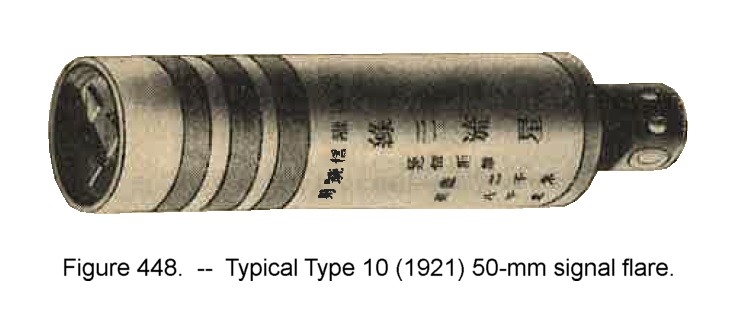
Anotgher version of teh Type 10 (1921) illuminating shell, knwon as the "Model B", is believed to exist, having
a different illuminating compound.
c. Type 89 (1929) 70-mm illuminating shell.
This shell is designed for use in the Type 11 (1922) 70-mm mortar, and, with the exception of the fuze, closely
resembles the Type 11 (1922) 70-mm HE shell. Although no specimen has been recovered *as of 1944), it is known
that the flare is suspended by a parachute.
Characteristics:
| 1. |
Weight |
--------- |
5.5 pounds. |
| 2. |
Fuze |
--------- |
Type 89 (1929) small, time. |
| 3. |
Period of illumination |
--------- |
20 seconds. |
| 4. |
Rate of fall |
--------- |
10 to 16 feet per second. |
| 5. |
Maximum vertical range |
--------- |
1,090 yards. |
d. Type 95 (1935) 70-mm illuminating shell.
No specimen has been recovered of this shell of this shell, as of 1944, which is fired from the Type 92 (1932)
70-mm infantry gun. It is believed that the shell consists of a steel body containing a parachute supported
illuminating charge. An ejection charge is used to expel the illuminating charge from the base of the
projectile. The altitude at which the illuminating charge is expelled is controlled by use of a time fuze
fitted to the nose of the shell.
Characteristics:
| 1. |
Weight, fuzed |
--------- |
7.7 pounds. |
| 2. |
Weight of illuminatign compound |
--------- |
1 pound. |
| 3. |
Type of fuze |
--------- |
Type 89 (1929) small, time. |
| 4. |
Period of illumination |
--------- |
Approximately 20 seconds. |
| 5. |
Intensity of illumination |
--------- |
90,000 candlepower. |
| 6. |
Maximum range |
--------- |
2,850 yards. |
e. Type 90 (1930) 75-mm illuminating shell.
When fitted with the suitable cartridge case, the shell can be fired from any of the Japanese 75-mm field
artillery weapons. The steel projectile is fitetd with a time fuze, and contains a parachute supported
illuminating charge. An ejection charge expels the illuminating charge through the base of the projectile
at the prescribed time.
Characteristics:
| 1. |
Weight, fuzed |
--------- |
12.4 pounds. |
| 2. |
Length, fuzed |
--------- |
12.2 inches. |
| 3. |
Weight of illuminating compound |
--------- |
1 pound. |
| 4. |
Type of fuze |
--------- |
Type 5 (1916) modified combination (time and impact). |
| 5. |
Markings |
--------- |
Old system; red with white characters.
New system: Black body with kana symbol in yellow and characters in white.
|
f. Type 89 (1929) 150-mm illuminating shell.
This projectile has not been recovered, as of 1944, but it is believed to be fired from any Japanese 150-mm
field artillery weapon.
Characteristics:
| 1. |
Weight, fuzed |
--------- |
84.1 pounds. |
| 2. |
Length, fuzed |
--------- |
21.2 inches. |
| 3. |
Type of fuze |
--------- |
Type 5 (1916) modified, combination (time and impact). |
| |

